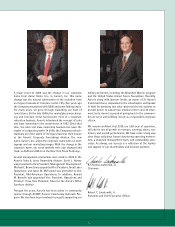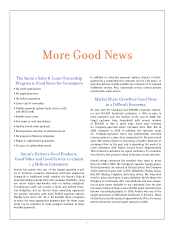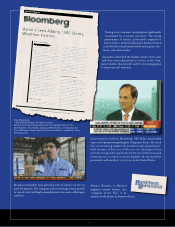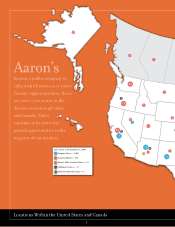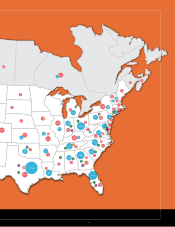Aarons 2009 Annual Report Download - page 17
Download and view the complete annual report
Please find page 17 of the 2009 Aarons annual report below. You can navigate through the pages in the report by either clicking on the pages listed below, or by using the keyword search tool below to find specific information within the annual report.
Aaron’s, Inc. is a leading specialty retailer of consumer electronics,
computers, residential and office furniture, household appliances
and accessories. Our major operating divisions are the Aaron’s
Sales & Lease Ownership Division and the MacTavish Furniture
Industries Division, which manufactures and supplies the majority
of the upholstered furniture and bedding leased and sold in our
stores.
Aaron’s has demonstrated strong revenue growth over the
last three years. Total revenues have increased from $1.395 bil-
lion in 2007 to $1.753 billion in 2009, representing a compound
annual growth rate of 12.1%. Total revenues for the year ended
December 31, 2009 were $1.753 billion, an increase of $160.2
million, or 10.1%, over the prior year.
Most of our growth comes from the opening of new sales
and lease ownership stores and increases in same store revenues
from previously opened stores. We added a net of 45 company-
operated sales and lease ownership stores in 2009. We spend on
average approximately $600,000 to $700,000 in the first year
of operation of a new store, which includes purchases of lease
merchandise, investments in leasehold improvements and financ-
ing first year start-up costs. Our new sales and lease ownership
stores typically achieve revenues of approximately $1.1 million in
their third year of operation. Our comparable stores open more
than three years normally achieve approximately $1.4 million in
unit revenues, which we believe represents a higher unit revenue
volume than the typical rent-to-own store. Most of our stores
are cash flow positive in the second year of operations following
their opening.
We also use our franchise program to help us expand our
sales and lease ownership concept more quickly and into more
areas than we otherwise would by opening only company-oper-
ated stores. Our franchisees added a net of 93 stores in 2009. We
purchased 19 franchised stores during 2009. Franchise royalties
and other related fees represent a growing source of high mar-
gin revenue for us, accounting for approximately $52.9 million
of revenues in 2009, up from $38.8 million in 2007, representing
a compounded annual growth rate of 16.8%.
SAME STORE REVENUES. We believe the changes in same store
revenues are a key performance indicator. The change in same
store revenues is calculated by comparing revenues for the year
to revenues for the prior year for all stores open for the entire
24-month period, excluding stores that received lease agreements
from other acquired, closed or merged stores.
In this management’s discussion and analysis section, we review
the company’s consolidated results including the five components
of our revenues (lease revenues and fees, retail sales, non-retail
sales, franchise royalties and fees, and other revenues), costs of
sales and expenses (of which depreciation of lease merchandise is
a significant part).
REVENUES. We separate our total revenues into five components:
lease revenues and fees, retail sales, non-retail sales, franchise
royalties and fees, and other revenues. Lease revenues and fees
include all revenues derived from lease agreements from our
stores, including agreements that result in our customers acquiring
ownership at the end of the term. Retail sales represent sales of
both new and lease return merchandise from our stores. Non-retail
sales mainly represent new merchandise sales to our sales and
lease ownership division franchisees. Franchise royalties and fees
represent fees from the sale of franchise rights and royalty pay-
ments from franchisees, as well as other related income from our
franchised stores. Other revenues include, at times, income from
gains on asset dispositions and other miscellaneous revenues.
COST OF SALES. We separate our cost of sales into two compo-
nents: retail and non-retail. Retail cost of sales represents the
original or depreciated cost of merchandise sold through our
company-operated stores. Non-retail cost of sales primarily repre-
sents the cost of merchandise sold to our franchisees.
OPERATING EXPENSES. Operating expenses include personnel costs,
selling costs, occupancy costs, and delivery, among other expenses.
DEPRECIATION OF LEASE MERCHANDISE. Depreciation of lease
merchandise reflects the expense associated with depreciating
merchandise held for lease and leased to customers by our stores.
Revenue Recognition.
Lease revenues are recognized in the month they are due on the
accrual basis of accounting. For internal management reporting
purposes, lease revenues from the sales and lease ownership divi-
sion are recognized as revenue in the month the cash is collected.
On a monthly basis, we record an accrual for lease revenues due
but not yet received, net of allowances, and a deferral of revenue
for lease payments received prior to the month due. Our revenue
recognition accounting policy matches the lease revenue with
the corresponding costs, mainly depreciation, associated with the
lease merchandise. At December 31, 2009 and 2008, we had a
revenue deferral representing cash collected in advance of being
due or otherwise earned totaling $37.4 million and $32.2 million,
respectively, and an accrued revenue receivable, net of allowance
for doubtful accounts, based on historical collection rates of $5.3
million and $4.8 million, respectively. Revenues from the sale of
merchandise to franchisees are recognized at the time of receipt
of the merchandise by the franchisee and revenues from such sales
to other customers are recognized at the time of shipment.
Lease Merchandise.
Our sales and lease ownership division depreciates merchandise
over the agreement period, generally 12 to 24 months when


